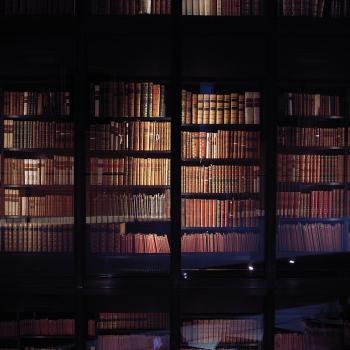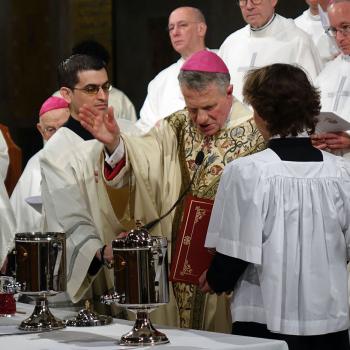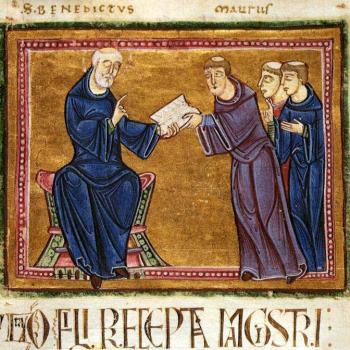By Edward J. Blum
 God in America is the cinematic realization of how the last thirty years of American religious history have redefined the study not only of religion, but also of America itself. The film is a beautiful revelation of the quests for religious freedom and diversity in the United States from two centuries before the nation's founding to the political cultural wars of the late 20th and early 21st centuries. This six-part series is visually stunning -- with vibrant splashes of contrasting colors to highlight the drama of the nation's religious heritage, with etchings, paintings, and film footage to show the grit and texture of faiths, and with brilliant commentary from many of the finest scholars in the nation to illuminate the trends and developments. God in America centers on the quest for religious freedom from the Pueblo revolt of the 1680s to the conflicts over school prayer in the mid-20th century. Along the way, we watch ministers, immigrants, reformers, attorneys, politicians, activists, and children struggle to live by their own consciences in a nation that frees and constrains them. God in America is a triumph, and anyone invested in the life of the United States should watch it.
God in America is the cinematic realization of how the last thirty years of American religious history have redefined the study not only of religion, but also of America itself. The film is a beautiful revelation of the quests for religious freedom and diversity in the United States from two centuries before the nation's founding to the political cultural wars of the late 20th and early 21st centuries. This six-part series is visually stunning -- with vibrant splashes of contrasting colors to highlight the drama of the nation's religious heritage, with etchings, paintings, and film footage to show the grit and texture of faiths, and with brilliant commentary from many of the finest scholars in the nation to illuminate the trends and developments. God in America centers on the quest for religious freedom from the Pueblo revolt of the 1680s to the conflicts over school prayer in the mid-20th century. Along the way, we watch ministers, immigrants, reformers, attorneys, politicians, activists, and children struggle to live by their own consciences in a nation that frees and constrains them. God in America is a triumph, and anyone invested in the life of the United States should watch it.
Paramount to this telling of American religious history is the nation. Although religious freedom stands as the main theme of God in America, it is how that freedom has been realized, experienced, and complicated vis-à-vis the United States. Anne Hutchinson, for instance, stands "as the future" of the nation for her religious individualism and dissent in 1630s Massachusetts Bay. In life, she was exiled for her challenges to the Puritan leadership and eventually killed by Indians, but her legacy of liberty was illustrative for the nation to come.
The Civil War has an entire hour of the series with the moral thinking of Abraham Lincoln taking center stage. In the fourth episode, Jewish immigrants of the Gilded Age make the effort to figure out and annunciate their relationship to "America." In the fifth episode, the Cold War is the main focus. Fearful of Communism and Soviet atomic capabilities, Americans led by Billy Graham and Dwight Eisenhower tied their nation to God in new and profound ways. The final segment examines how the United States became the most religiously plural nation in the world and how the "religious right" looks to operationalize moral authority through political power. It is the "America" of God in America that really counts.
God in America was possible because of a seismic shift over the past thirty years in the academic telling of American religious history. Before 1980, most scholars viewed religion as something influenced by and acted upon by other forces. Economics, politics, and social change drove religion. The "social control" thesis was a standard one, where even religiously-based reform movements were understood not for their faiths, but for their fears and quests to dominate.
How the times have changed. The new band of religious historians have looked to every nook and cranny of national development to find religion as a prime player in the making, breaking, and repairing of the nation. The examples are legion. The quest for religious liberty influenced the quest for political liberty in the American Revolution. Scripture and denominational conflict over slavery led to the Civil War. New Catholic and Jewish immigrants struggled with what it meant to be American by refracting their political, social, and cultural participation through their religious worldviews. The Cold War was understood as a moral war, and the late 20th and early 21st centuries are defined by religious pluralism and political engagement. Faith is not so much acted upon in God in America, but the key actor in the drama of the nation. Karl Marx has met his match. Religion is not an opiate, but a stimulant.
The intellectual genius behind God in America is Stephen Prothero, professor of religion at Boston University and author of some of the best-known books in the field. His American Jesus (2004) situated cultural renderings of Jesus at the heart and soul of the American project, and Prothero's engagement with presenting religion to the American public has been staggeringly expansive. His vision emerged from a wide array of new texts. Of the Puritans, we behold the innovative work of Harry Stout, Stephen Marini, David Lambert, Thomas Kidd, Amanda Porterfield, Edwin Gaustad, and Catherine Brekus. Of the 19th century, it's the contributions of Mark Noll, John Boles, Allen Guelzo, Daniel Stowell, Cynthia Lylerly, Charles Irons, R. Laurence Moore, George Marsden, and Jonathan Sarna. Of the 20th century, it's the fantastic work of John McGreevy, Paul Harvey, Clayborne Carson, Rosetta Ross, Jonathan Bass, Stephen Miller, Randall Balmer, and Grant Wacker. There are many to thank for this effervescence, and Prothero has brought them together exquisitely.




